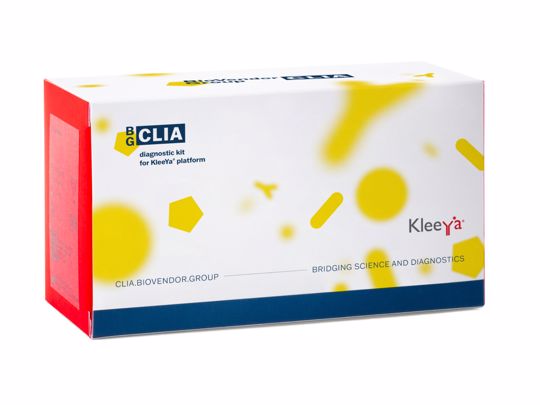CLIA CRP wide-range
Chemiluminescence kit for the determination of C-reactive protein (CRP) in human serum and plasma.
Chemiluminescence kit for the determination of C-reactive protein (CRP) in human serum and plasma.
| Catalog Number: | CL-CRP100 |
|---|---|
| Size: | 100 tests |
| Clinical topic: | Sepsis & Inflammation |
| Diagnostic panel: |
COVID-19 SIRS, Sepsis, and Severe Viral Infection |

C-reactive protein (CRP) is an acute inflammatory protein that increases up to 1,000-fold at sites of infection or inflammation. CRP is accepted in clinical use as a major, although rather non-specific, marker of local or systemic inflammation, bacterial infection, and sepsis.
Changes in the concentration of CRP are used to help evaluate for acute bacterial or fungal infections, identify postoperative complications, and monitor chronic inflammatory conditions such as autoimmune diseases, certain types of arthritis, and IBD. They also help evaluate the response to antibiotic treatment of bacterial infections and therapy in people with chronic inflammation.
In patients with COVID-19, admission CRP correlated with disease severity and tended to be a good predictor of adverse outcomes.
The inflammation process plays a key role in the pathogenesis of atherosclerosis, development of arterial hypertension, heart failure, valvular disease, and atrial fibrillation. The formation of cholesterol-rich plaque inside arteries is the root cause of most heart attacks and strokes.
CRP has long been recognized as an inflammatory marker and suspected of playing a role in the atherosclerotic process. Recent guidelines recommend high sensitivity CRP testing for primary CVD prevention, stratifying CVD risk groups, and select patients for statin therapy. It can also be used to prognosticate complications of CVD itself and to evaluate treatment efficacy. The CDC/AHA guidelines support the use of CRP in primary prevention and set cutoff points according to relative risk categories: low risk (<1.0 mg/L), average risk (1.0-3.0 mg/L), and high risk (>3.0 mg/L).
| Assay time | 30 min |
| Assay stability | 30 days on board stability / In use stability until the expiration date at storage temperature 2-8 °C |
| Sample matrix | Serum, Plasma |
| Sample volume | 15 µL |
| Measuring range | 0,5–360 mg/l |
| Assay/kit content | Reagent Cartridge with specific reagents for the assay, magnetic particles, calibrators |
| Complementary products | Wash buffer, Anchor® Tips, Stackable cuvettes, Trigger solutions |
| Note | C-reactive protein (CRP) is a protein associated with acute inflammation which increases up to 1000-fold at the location of infection or inflammation. In the clinical practice, CRP is established as a major, although non-specific, marker of local or systemic inflammation, bacterial infection and sepsis. Changes in CRP levels are utilised to evaluate acute bacterial or fungal infections, identify postoperative complications, and monitor chronic inflammatory conditions, e.g. autoimmune diseases, certain types of arthritis, and IBD. They also facilitate the assessment of the response to antibiotic treatment in bacterial infections and monitoring of therapy in people with chronic inflammation. In the COVID-19 pandemic, CRP levels in admitted patients correlated with disease severity and predicted adverse disease progression. Inflammatory process plays a key role in the pathogenesis of atherosclerosis as well as in the development of arterial hypertension, heart failure, valve disease and atrial fibrillation. The formation of cholesterol-rich plaques in the arteries is a major cause of most heart attacks and strokes. It has long been suspected that CRP, an inflammatory marker, plays a role in the development of atherosclerosis. Current guidelines recommend testing for low CRP levels in primary CVD prevention, stratification of CVD risk groups, and selection of patients for statin therapy. Another utilisation is the prediction of CVD complications and evaluation of the effectiveness of treatment. The CDC/AHA guidelines support the use of CRP in primary prevention and set cut-off values according to relative risk categories: low risk (<1.0 mg/l), average risk (1.0-3.0 mg/l) and high risk (>3.0 mg/l). ERM-DA474/IFCC standard was used to set the calibration curve of the kit. |